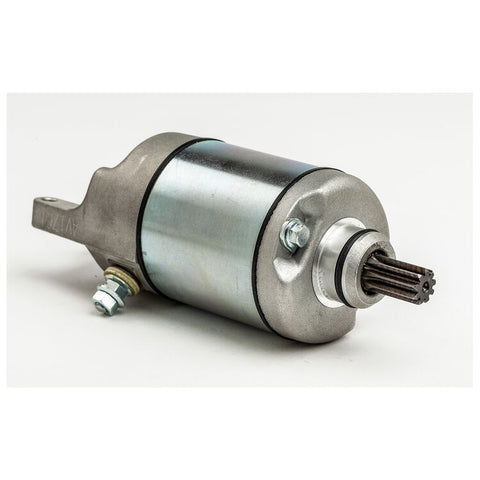
The starter motor in your motorcycle is a strong electric device that must turn the engine over and start the combustion process before it can continue on its own. To crank the engine, you'll need an electric motor that can deliver a lot of torque in a short period of time, on demand, and over and over. That is exactly what the starting motor is, plus a system that allows it to mechanically engage and disengage in a moment.

But, how does the starting motor function? When you turn the key, electricity is transmitted to the ignition system, which fires the spark plugs, and to a bigger magnetic switch, which delivers a surge of power directly from the battery to the starter.

The solenoid is a magnetic switch that is often fastened to the starter itself, switching high amperage power and causes the gears to mesh. When the electromagnet is activated, the solenoid plunger links the thick battery wire to windings within the starter to spin the electric motor, as well as pushing a rod, engaging a fork, which in turn pushes a pinion gear (attached to the motor) to engage with the flywheel automatically.

The starter requires the most power of any component on your automobile, which is why the first sign of a depleted battery is difficulty starting. If you turn the key and just hear "click, click, click, click," it's likely that the battery lacks enough power to crank the starter, but the solenoid is working.
A starter motor might fail in a variety of ways, but it seldom happens all at once. If the starter's internal mechanical parts (for example, the bearings) begin to fail, it will require more force to turn it until it no longer turns quickly enough to start the engine. If the insulation on the armature winding begins to deteriorate, the starter will lose torque and may refuse to turn the engine over, even with a fully charged battery. If the starting just clicks but does not turn and the battery is fully charged, the contacts within the solenoid or commutator are likely old or unclean and not carrying electricity as well as they should. Sometimes a starter will work fine in the morning, but not crank once it has gotten warm from driving.

What are the signs that i need to change my starter motor

If the starter motor appears to be dead, you must first rule out the battery as a possible source of the problem. Are the other electrical components operating properly (headlights, inside lights, electronic windows) or is the battery dead? Are the battery terminals rusted or in excellent condition? Examine the starting motor solenoid terminal as well. If required, clean them. Check the fuse(s) and measure the voltage at the starting solenoid control terminal with the ignition key in the 'start' position. If voltage is present, there is most likely a problem with the starting motor.
The brushes on the starting motor are the most prone to wear. The minimum length is not specified, however anything more than 5 mm should be adequate (dependent on the starter motor). Check to see whether the brushes are cracked, chipped, or otherwise damaged. Check that each brush is properly attached to its wire, and that the wire is securely attached to its termination. Check the springs in the brush housings for wear.

Look for scoring, scratches, and discolouration on the commutator bars. Crocus cloth can be used to clean and polish the bars; do not use sandpaper or emery paper. Wipe away any residue with a towel soaked in an electrical system cleanser or denatured alcohol after cleaning. Check that the insulating material (mica) between each of the bars is below the bars themselves and carefully scrape any away if required.
Using an ohmmeter or a continuity test light, check for continuity between the commutator bars . Continuity should exist between each bar and all of the others. Also, check for continuity between the commutator bars and the armature shaft (see illustration) . There should be no continuity (infinite resistance) between the commutator and the shaft. If the checks indicate otherwise, the armature is defective.

Comments